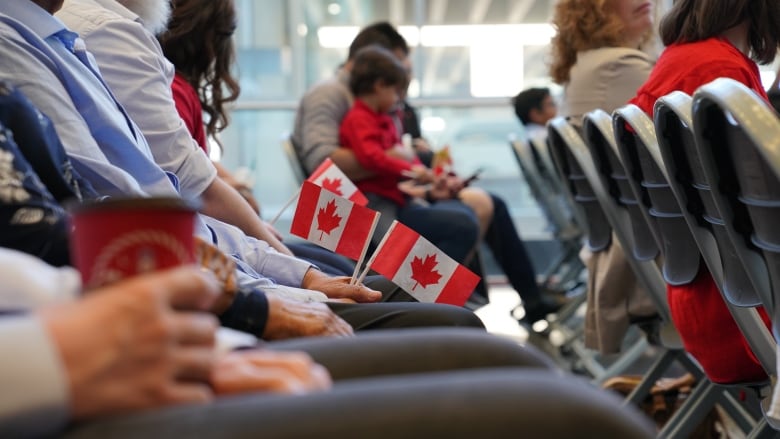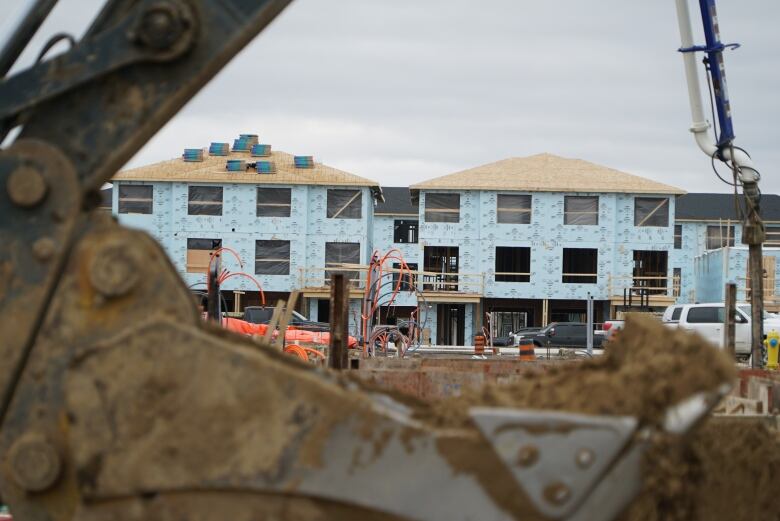Linking immigration to the housing shortage may be missing the problem, experts say
Canada now has more than 2.5M non-permanent residents, a number experts say is driving up rents

With rising rents and house prices making it increasingly hardto find an affordable place to live, some are pointing the finger at Canada's record-levelimmigration rates.
Immigration is not the only thing putting a strain on the housing market. High interest rates, increasing building costs and red tape at the municipal level that can slow down or halt home construction are all part of the picture.
But to tackle the pressure being created by immigration, some are now openly discussing forginga public policy link between how many people Canada takes in each year and the state of the country's housing stock.
"It's very simple math. If you have more families coming than you have housing for them, it's going to inflate housing prices," Conservative Leader Pierre Poilievre told an audience in Winnipeg recently.
Poilievre has offeredfew details on how agovernmentled by him would handleimmigration, but he did say it wouldtake three factors into consideration.
"We have to bring the [immigration] numbers in line with the number of houses that are built," he said. "The growth in immigration should not exceed the amount of housing stock we add, the number of doctors we addand the available jobs."
- This week Cross Country Checkup wants to know: Has the housing shortage changed your view on Canada's immigration strategy? Fill out the details on this form and send us your stories.
CBC News has asked the Conservative leader for more details of his plan to tie immigration to housing,but hasyet to receivea response.
The Liberals also have acknowledgedthat the number of people coming into the country is making the housing crisis worse.
But experts and economists say that targeting immigration broadly won't bring the cost of housing down. What's required, they say, is a more nuanced approach.
Canada's immigration picture has changed dramatically in recent years.
In the fall of 2022, the Liberal government announced its plan to increase the annual permanent resident target from 405,000 in 2021to 465,000 in 2022, before stabilizing at 500,000in 2024 almost double the 260,411 permanent residents who arrivedin 2014.
But new permanent residents are only part of the immigration story.
Statistics Canada reported a total population increase of 1,158,705 permanent and non-permanent residents as of July 1, 2023, a 2.9 per cent increase over July 1, 2022 and the highest population growth rate recorded for a 12-month period since 1957.
The agency said 98 per cent of that increase was due to immigration, while the remainder was due tonatural increase the difference between births and deaths.
Statistics Canada said that by the end of 2023, there were 2,511,437 non-permanent residents in the country a class that includes international students and temporary foreign workers compared to 1,305,206 in the fall of 2021.
Houses vs. households
Many housing experts say tying the official immigration target even at the 500,000 per year level to the number of houses built each yearwon't make housing more affordable.
David Hulchanski, a professorof housing and community development at the University of Toronto's Factor-Inwentash Faculty of Social Work,saidnew arrivals are free to live where they want which may not be where housing is available.
"Are we going to require all immigrants to stay in place?" he asked.
Hulchanski said it's also important to distinguish between households and homes because "the 40 million people in Canada don't live in 40 million houses."
Canadian households, he said,have an average of about 2.45 people. In Germany it's just 2.14 people per household, whilein Ireland it's 2.73 people per household.
By that measure, he said, 500,000 immigrants would need about 204,000 homes in Canada, 233,000 homes in Germany and just 183,000 in Ireland.

CMHC figures released this week show housing starts are down seven per cent since 2022. Hulchanski said thatstill amounted to223,513new starts last year, enoughto accommodate incoming permanent residents.
Other pressuresare driving down the number of housing starts:high interest rates making home ownership less affordable,the increased cost of building materialsdue toinflation and supply chain disruptions lingering from theCOVID-19 pandemic, and zoning laws at the municipal levelthat make it harder to build homes.
Hulchanski said it's important to remember that "homes are not households" and tying immigration to the availability of housing assumes all immigrants are the same, with the same housing needs.
People immigrating to Canada through the family reunification stream are, he said, more likely to live withfamily members than to seek separate housing. Some immigrants come as complete families and will live together, he said, while others may be wealthy and able to afford housing at inflated prices.
"The challenge with actually having a policy that links the number of immigrants to houses is that households don't equal immigrants," he said. "There's a big disparity there."
Immigrants vs. international students
Still,Hulchanski and other housing experts see a clear link between non-permanent immigration and housing availability.
The massive recent spike in non-permanent residents, they say, has had a substantialimpact on housing affordability.
In 2011, for example, the number of international students in the country was just shy of 240,000. Late last year, Immigration Minister Marc Miller said Canada was on track to host as many as 900,000 international students in 2023.
"We exponentially increased demand [for housing]," said Stephen Pomeroy, a professor and housing expert at McMaster University.
"Temporary foreign workers and students don't come to buy homes. They rent. So we've had a massive demand impact on the rental part of the housing system."

Pomeroysaidthat while the annual immigration target has been well managed, provincial and federal governments have lost control of non-permanent resident programs that bring in students and temporary workers.
Housing Minister Sean Fraser admitted as much this week in Halifax when he told reporters "the temporary foreign workers program, and in particularthe international student program," were making the housing crisis worse.
Fraser singled out colleges that do not grant degrees but rather provide diplomas to international students.
"There are some institutions in different parts of this country that, I have the sincerely held belief, have come to exist just to exploit the program for the personal financial gains of the people behind some of these schools, if we can call them that," he said.
Pomeroy said cutting as many as 700,000 international students out of the system would reduce rental pressures in some areas without hurting the universities that have come to rely on the high tuition fees such students pay.
Irfhan Rawji ischair of the Institute for Canadian Citizenship, which helpssettle new immigrants in Canada. He told CBC Radio's The Current this week that if Canada's immigration intake is going to be tied to housing, targeting the right kind of immigration is critical.
"Do we need 800,000 students studying skills maybe this economy doesn't need, living in houses that we don't have? Of course that's not sustainable, but we don't want to throw the baby out with the bathwater," he said.
Rawjisaid he worries about Canada losing the economic value that immigrants entering through the permanent resident program deliver.
The right mix
"I think what's happened probably since the 1990s is that different corporations in Canada, business lobby groups, have seen more immigration as just an unambiguously good thing," said Christopher Worswick, economics chair at Carleton University.
The Canadian Chamber of Commerce says building more homes is preferable to cutting immigration.
Pascal Chan, the chamber's infrastructure and construction director, told CBC News the chamber sees immigration asgoodfor business and wants to see it focus on attracting skilled workers.
"Looking at restricting demand versus looking at increasing the supply to get to the levels we need to be, I think that the focus should really be on increasing that supply as well," he said.
Hulchanski said that to bring the cost of housing down, Canada has to help people at the lower end of the income scale.
"If you ask any housing researcher now, any place on earth, how do you house low income people? Well, the market can't do it," he said.
He said only four per cent of Canada's housing stock issocial housing dwellings that are supported in whole or in partby government funding.Social housingaccounts for 18 per cent of the United Kingdom's housing stockand 17 per cent of housing inFrance.
While social housing makes up only three per cent of the housing stockin Germany, that country offers significant breaks to developers building social housing and props people up with financial incentives.
Hulchanski said that focusing on immigration as a cause, and promising to reduce it in order to bring housing costs down, is "just another way of avoiding the real discussion, that we need systemic change."
"In this case, the solution would be saying we're going to increase social housing from, say 4 per cent to 16 per cent of the mix, or 20 per cent of the mix," he said.













_(720p).jpg)


 OFFICIAL HD MUSIC VIDEO.jpg)
.jpg)



























































































